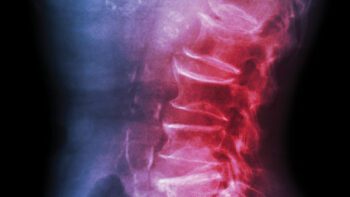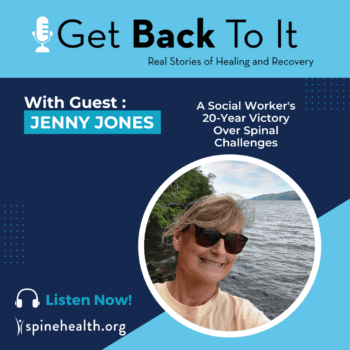By Neville Alleyne, MD , OSNC Orthopedic Specialists of North County
DISC HERNIATIONS EXPLAINED
The spine is made up of alternating bones and discs, where the bones are strong and provide support while the discs are pliable and provide movement. Discs are made up of an inner cartilaginous core surrounded by a thick outer ligamentous ring. A lumbar disc herniation occurs when part of the inner core breaks through the outer ligament in the lowest part (lumbar) of the spine. Lumbar disc herniations most often cause leg pain because a nerve becomes irritated and/or compressed by the herniation. Lumbar disc herniations occur frequently in the age groups ranging from 20 to 50 years. Approximately 90% of lumbar disc herniations occur at the lowest two lumbar disc levels, L4/5 and L5/S1.

NON-SURGICAL TREATMENTS
Fortunately, there are extensive non-surgical treatment options which are often successful at improving or eliminating symptoms, including the use of anti-inflammatories, antispasmodics, mild/short-term opioid analgesics, physical therapy, chiropractic treatment, acupuncture, and/or the use of pain management procedures such as epidural injections, facet injections, or radiofrequency ablation. Non-surgical treatment can achieve good results, but patients must do their part in assisting with recovery. These basic interventions can be successful at staving off the need for surgery:
- Reduce weight (BMI)
- Eat appropriate meals, especially those afflicted with diabetes
- Quit smoking/nicotine
- Perform adequate exercise and core strengthening
SURGICAL TREATMENT: MICRODISCECTOMY
There are approximately 450-500 thousand discectomies performed in the United States each year to surgically treat lumbar disc herniations. Microdiscectomy can be considered after an appropriate period of conservative treatment (2 to 3 months) fails to provide significant improvement, but would be considered sooner if there is a progressive neurologic deficit. Such a deficit could include weakness in the:
- Ankle
- Foot
- Toes
- Hamstring
- Quadriceps
- Hip flexor
Although less common, urgent surgical intervention is warranted in the event of progressive neurological deterioration such as loss of bowel or bladder function, loss in perineal sensation, and weakness in the lower extremities. This rare condition is called, “cauda equina syndrome.”
When surgical intervention is indicated, microdiscectomy is a great surgical option. This type of surgery is small (micro) and can be done using a high powered microscope or through a cannulated tube with minimal disruption to the soft tissues, resulting in a very small incision that facilitates faster recovery. During surgery, the piece of displaced disc material is removed relieving the pressure on the nerve. Patients can leave the ambulatory center or hospital the same day of surgery. Initiating physical therapy within 2-3 weeks after surgery can be very helpful in getting the muscles to recover and allowing nerve function to return.
These procedures can sometimes be completed within an hour and other times can take twice as long. Performing an elegant microdiscectomy can be one of the more challenging operative procedures we perform as spine surgeons. With limited resection of bone and/or ligament, this procedure will impart minimal disruption and instability to the spine. As with all procedures, when done well, it is extremely gratifying.
Microdiscectomy procedures have a success rate of 70-90% and the best surgical outcomes occur in patients that do not postpone surgery longer than 6 months to 1 year. Beyond one year of symptoms, success can drop down to approximately 80%. I usually tell my patients they can expect an 80-85% success rate with microdiscectomy.
RISKS AND COMPLICATIONS
Although a first time microdiscectomy has a very high success rate, there is a chance that another disc herniation occurs in that same location (called a recurrent disc herniation). The rate of recurrence can be 10-25% within the first year after the initial surgery. This is usually related to a weak area in the ligamentous ring allowing more disc material to extrude through, resulting in a re-herniation. Additional surgical intervention may be needed in the event of a recurrent disc herniation.
Occasionally, scar tissue can develop after surgery causing similar nerve symptoms over time. In these situations careful history, physical examination, and imaging may be helpful. Other potential surgical complications include but are not limited to: infection, battered nerve root syndrome, cerebrospinal fluid leak, arachnoiditis, epidural fibrosis, or residual pain secondary to failure in retrieving all the disc fragments that herniated. Although the risk of these complications is often low, each patient should discuss their individual risk with their surgeon.
CHOOSING A SURGEON
Choosing the best surgeon can be daunting, but do not be afraid to ask questions, such as:
- How many of these procedures do they perform each year?
- What is his or her success rate?
- Is the facility capable of handling any of the above complications if they were to occur?
- Who performs the anesthesia, a physician or nurse anesthetist? If it is a nurse anesthetist, is an anesthesiologist supervising or providing backup?
- What is the overall infection rate at the facility?
- What is the surgeon’s infection rate for this procedure?
In summary, although the evidence shows that many patients will improve without surgical intervention, microdiscectomy is a safe and effective procedure for those with symptomatic lumbar disc herniations that have failed conservative treatment. Prior to microdiscectomy, patients must commit to a lifestyle change and follow the pre- and post-operative instructions of their physician and therapist. Eliminate fear by asking appropriate questions and to speak to another patient with similar findings and similar demographics (age, sex, weight, etc). A positive attitude and knowledge of the procedure will go a long way in achieving a great surgical experience.
To read more articles like this one on deciding to have disc surgery, go to our Spine Health Journal.
References
- Shriver MF, Xie JJ, Tye EY, Rosenbaum BP, Kshettry VR, Benzel EC, Mroz TE. (2015). Lumbar microdiscectomy complication rates: a systematic review and meta-analysis. Neurosurgical Focus, 39(4), 1–11. http://thejns.org/doi/abs/10.3171/2015.7.FOCUS15281
- Koebbe CJ, Maroon JC, Abla A, El-Kadi H, Bost J. (2002). Lumbar microdiscectomy: a historical perspective and current technical considerations. Neurosurgical Focus, 13(2), 1–6. doi: 10.3171/foc.2002.13.2.4. PMID: 15916400.
- Solberg TK, Nygaard ØP, Sjaavik K, Hofoss D, Ingebrigtsen T. (2005) The risk of “getting worse” after lumbar microdiscectomy. Euro Spine Journal. 14, 49–54. DOI 10.1007/s00586-004-0721-5



